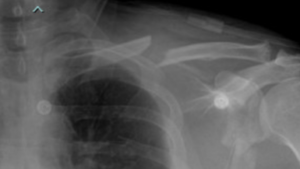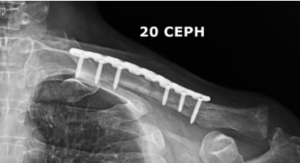Clavicle Fracture Postoperative Protocol
The Reno Orthopedic Center Fracture and Trauma Surgeons have created postoperative fracture protocols for our patients. These are based on the latest orthopedic science and literature in order to give patients the most up to date care. Their content is designed to explain what type of injury was sustained, the type of surgery that was done and simple instructions for weight bearing, wound care, physical therapy, medicine and diet issues. Patients will hear similar information in each postoperative visit but it is easy to forget what is said. The following protocol is designed to help patients in their healing with a single resource for frequently asked questions.
What Was Broken
You broke your collarbone which is called the clavicle.

Illustration of the clavicle bone. Reproduced with permission from OrthoInfo. © American Academy of Orthopaedic Surgeons. https://orthoinfo.org/

Preoperative x-ray of clavicle fracture.
What Was Done in Surgery
Your collarbone was fixed with a titanium plate and screws. The surgery often requires 6-10 screws depending on the fracture pattern.

Postoperative x-ray of clavicle fracture repair.
Follow Up Appointment
You should see your surgeon or his physician assistant 10-14 days after surgery. Usually, this appointment is made when you schedule surgery. If you do not have one, please call the office to schedule at 775-786-3040 as soon as you can. You will be seen at 2 weeks, 6 weeks and 3 months from surgery where the provider will examine you and x-rays will be taken to follow bone healing.
Wound Care
Your wound was closed with either sutures or staples. After 2 days you can take off the dressing. If the wound is dry, you do not need to cover it with a new bandage. If it is leaking, replace dressing with a clean gauze pad and tape.
Showering
You may shower immediately after surgery. Your dressing from surgery is waterproof. If it gets wet, remove the bandage, and place a new one. Do not immerse your wound in a bath or hot tub until your stitches or staples are removed.
Pain Control
You have been given a prescription for narcotic pain medication. You can take 1-2 pills every 4-6 hours. It is ok to take anti-inflammatory medicine like Motrin (ibuprofen) or Tylenol (acetaminophen) as well. Do not take more than 4 grams of Tylenol a day or it can hurt your internal organs. The orthopedic surgeon by law can only give you narcotic pain medicine for 2 weeks after surgery. This must be prescribed in only a 5 day supply each time. If you already get narcotics from your primary care doctor or pain management doctor the orthopedic surgeon cannot write you a separate prescription. If you need prolonged narcotics we can refer you to a pain management specialist. If these rules are bent, the orthopedic surgeon can lose his medical license, insurance contracts and be unable to care for other patients like you. Please respect these regulations.
Marijuana
THC and CBD products can be helpful for postoperative pain and decrease the amount of narcotics you need. In Nevada, marijuana is legal, and you do not need a doctor’s prescription to get it. THC use avoids the constipation and addiction potential associated with narcotic use. Edible use avoids the other risks associated with smoke inhalation and has more controllable dosing.
Diet
Eat a well-balanced diet. If you are diabetic keep your blood sugars well controlled. High blood sugar can put you at risk for infection, wound complications and the bone not healing (nonunion).
Sutures/Staples
Your wound has been closed with sutures or staples depending on your surgeon’s preference. They will be removed at your first postoperative follow up appointment 10-14 days after surgery.
Weight Bearing
You are given a sling for comfort after surgery. You do not need to wear it if you do not want to. You should not lift more than 15 pounds for the first 6 weeks after surgery. After that time if x-rays show good healing bone you can return to lifting, biking, motor cross, skiing, manual labor, etc.
Physical Therapy
Most patients with clavicle fractures do not need therapy. Because you can use your shoulder, arm, elbow, and wrist right away most patients do not get stiff. Your neck and chest muscles may feel a little tight initially after surgery since we sew these muscles over the metal plate to make it less prominent or bothersome.
Hardware Removal
The metal plate and screws usually stay in for life and are not routinely removed. However, if the metal becomes infected or is painful 1 year after surgery it can be removed.
Healing Time
The clavicle or collarbone treated with surgery takes about 3 months to heal completely. If too much activity is done too early the metal plate can break before bone is healed. Younger patients heal slightly faster and older patients or those with diabetes take slightly longer to heal.
